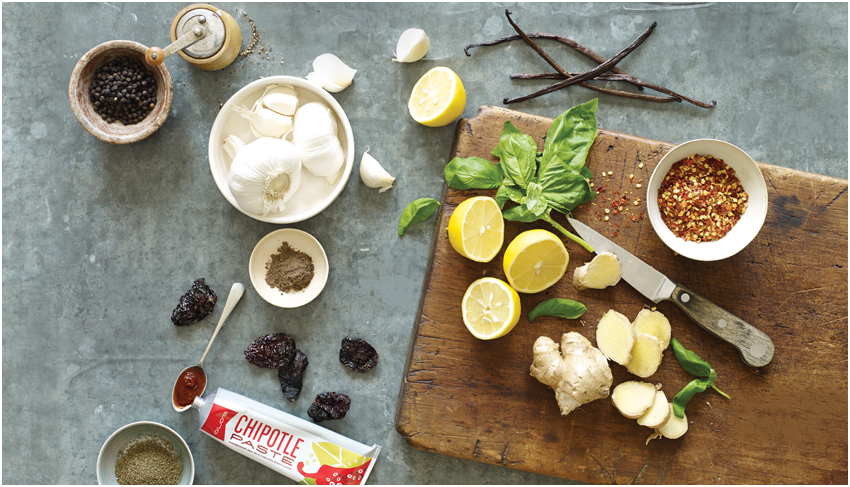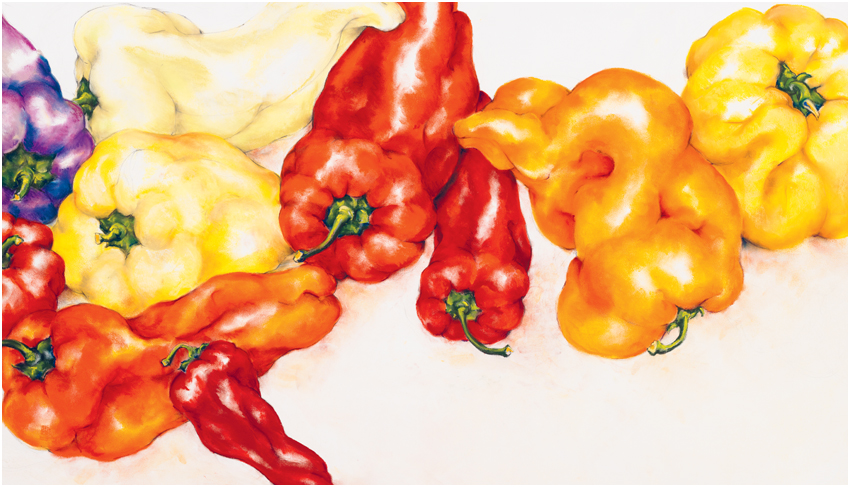

I’D NEVER BEEN TO INDIA. I WASN’T WELL-VERSED IN ITS CUSTOMS, ITS CULTURE, ITS GEOGRAPHY, ITS FLORA, ITS FAUNA—OR ITS FOOD.
So in 2012 I grabbed my Next Chapter team, my camera crew, my goddaughter, Kirby, and off we went to explore the world. I saw paradise and I saw poverty during my trip. In Jaipur, I was treated to the kind of luxury generally reserved for fairy tales, complete with painted elephants and bejeweled camels in the courtyard of a 300-room palace where I’d been invited to dine with royalty. The women wore jewel-toned silk saris and the men were every bit as elegant. The music was cinematic, the art and textiles were museum quality, and the night was beyond opulent. Everything was exquisite.
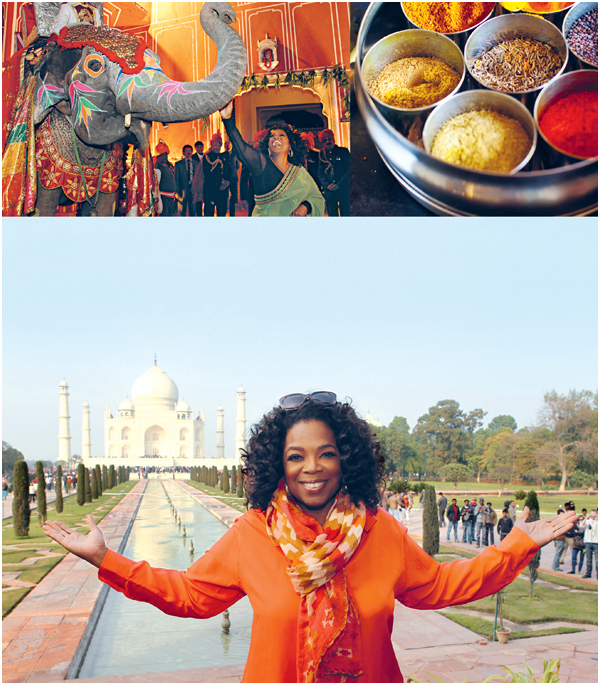
The Taj Mahal, described by Nobel laureate Rabindranath Tagore as “the teardrop on the cheek of time,” is awesome and intimate and a very long way from Kosciusko, Mississippi. It’s one of the most spectacular places I’ve ever been. No wonder it’s one of the seven wonders!
In the crowded slums of Mumbai, home to 10 million people, I met five who made a deep and lasting impression on me. Rajesh Hegde-Ray and his wife, Parvati, ate, slept, prayed, and raised their three daughters—six-year-old twins and their 12-year-old big sister—in a single concrete-walled room that measured no more than 10 feet by 10 feet. What can I say about this family? They had only themselves to give, and they gave with open hearts. They shared their time, they shared their goodness, and they shared one more unforgettable gift: masala chai.
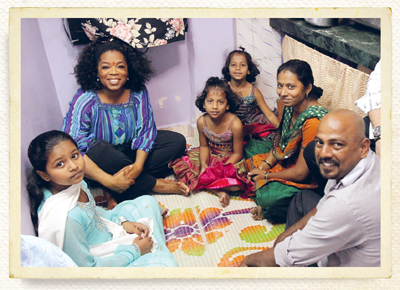
Sharing chai with the Hegde-Ray family in 2012. Their home is small on space but large on love.
As we sat together on the floor, Parvati reached behind the scrap of cloth that curtained off most of her family’s possessions, pulled out a simple tea set, and watched as Rajesh proceeded to brew the most transporting cup of tea I’d ever tasted. Was it the pungent mix of spices or the Hegde-Rays’ kind welcome that made it so distinctive? We sipped, we talked, and eventually we hugged our goodbyes. As I write this now, it occurs to me that just as I’d left Jaipur feeling honored to experience a night of opulence and pageantry, it was also an honor to witness a family of five laughing together, supporting each other, and functioning in harmony under circumstances most Americans would find hard to comprehend. Equally an honor, and equally delightful.
When I look back on that trip, I think of the soft pink light, the lyrical voices, the chaotic traffic, the people who seemed to wish everyone well, and the food. The first time I tasted Indian food was … in India! It was a revelation, starting with—you guessed it—the bread. Naan is a traditional flatbread, an unpretentious, warm, pillowy, puffy, chewy, heavenly flatbread, sort of like if pizza dough and a buttermilk biscuit got together and did their thing. The waiter brought us garlic naan and it was love at first bite. All I could do was keep asking for more, and more, until another waiter, equal parts alarmed and concerned, approached the table to ask, “Madam, should we cancel your meal?”
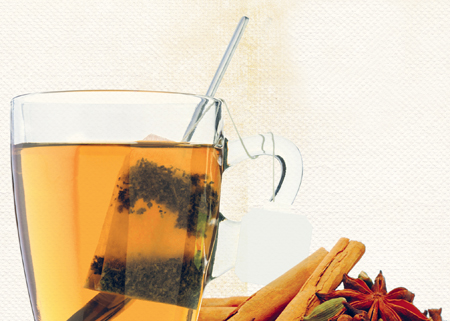
I love tea so much I came back and now make my own chai. Tea is one beverage you can drink all day, and it won’t cost you a point.

Meditation refreshes my mind, realigns my spirit, and returns me to myself again! It’s the key to clarity!
I came back from that trip wanting to bring naan and tea into my life at home—plus so many other spectacular dishes from around the globe. I now own a tandoor oven for baking naan, and I’m delighted to say I’ve mastered the art of chai.
I’ve come to understand that there’s a beauty, a sense of order, in the tea-making process. I wake up every day, I meditate, I take in the silence, and then I start the chai. As it steeps, my head clears; as the flavors develop, my thoughts come into focus. I get centered, I get calm. I get prepared for whatever the day is going to bring. I become aware of how the steam swirls and disappears; the woodsy, citrusy, spicy, floral fragrance; the way the translucent amber color slowly turns creamy beige with the almond milk. I spoon a stiff dollop of foam on top, and feel the warmth of the mug in my hands.
Next comes a cup for Stedman—I’ve got him hooked, too. As the morning unfolds, I’m often making chai for the folks who work with me, and anyone who happens by the front gate—“Hey repairman, UPS guy, want a cuppa chai?” I’m trying to carry on the spirit of hospitality, humility, and generosity that the Hegde-Rays greeted me with in their love-filled home. It feels like an act of grace to share a cup of tea with people, whatever language they speak, however they make their way in the world. If India taught me anything, it’s that we all want the same things: health, happiness, and a solid connection to our own humanity.
The recipes in this chapter celebrate the rich history and culture, the colors and flavors, and above all, the people of India, Vietnam, Thailand, and Japan. I hope when you start to cook, you’ll pause to do what I always do now: think for a moment of the beauty of the rituals in your life, and make room for one more person at your table. Namaste.
Looking for something to make for the vegetarian in your life? Look no further.
This recipe is so nourishing that I keep thinking it must be what Indian grandmothers make when somebody has a cold! Pumpkins, they aren’t just about pie and jack-o’-lanterns anymore!
PREP TIME 15 MINUTES | COOK TIME 1 HOUR | SERVES 6 | SMARTPOINTS 6 PER SERVING | CALORIES 216 PER SERVING
INGREDIENTS:
1 tablespoon coconut oil
1 large onion, finely chopped
3 garlic cloves, grated on a Microplane
2 tablespoons minced ginger
Seeds of 3 cardamom pods
½ teaspoon black mustard seeds
1 teaspoon ground cumin
1 tablespoon ground coriander
1 teaspoon ground turmeric
2 teaspoons garam masala
2 Kashmiri chiles or arbol chiles
1 (2-pound) pumpkin or winter squash, peeled, seeds removed, and cut into ¾-inch cubes
2 teaspoons salt
1 cup Vegetable Stock (here), plus more if needed
1 (14-ounce) can light coconut milk
1 (15-ounce) can chickpeas, drained and rinsed
Freshly ground black pepper
Large handful fresh mint leaves, chopped
Large handful fresh cilantro leaves, chopped
Lime wedges
Naan (here)
DIRECTIONS:
Heat the oil in a large, heavy-bottom pot over medium-high heat. Add the onions and cook for about 5 minutes, until softened. Add the garlic and ginger and cook for about 1 minute, until fragrant. Add the cardamom seeds, mustard seeds, cumin, coriander, turmeric, garam masala, and chiles and cook, stirring, until aromatic, about 1 minute, adding a tiny bit of water if the mixture starts to stick to the bottom of the pan. Add the pumpkin or squash, salt, vegetable stock, and coconut milk, bring to a simmer, then reduce the heat to medium-low and simmer until the pumpkin is starting to soften, about 20 minutes.
Add the chickpeas and simmer for an additional 10 minutes, or until the pumpkin is fully softened. Season with pepper, spoon into bowls, and serve topped with the mint and cilantro and with lime wedges and naan alongside.

RECIPE INSPIRED BY RICK STEIN
I first tried this rice pilaf dish in the Kashmiri region of India. The exotic spices—garam masala, ginger, cardamom, cumin, to name just a few—always remind me that there are a whole lot of extraordinary dishes in the world and that, really, nothing connects us quite like sharing food.
PREP TIME 15 MINUTES | COOK TIME 30 MINUTES | SERVES 4 | SMARTPOINTS 6 PER SERVING | CALORIES 220 PER SERVING
INGREDIENTS:
½ ounce dried morel mushrooms
1¾ cups hot water
1 cup white basmati rice
1 tablespoon vegetable oil
½ teaspoon garam masala
1 medium yellow onion, finely chopped
1-inch piece ginger, grated on a Microplane
3 cloves garlic, grated on a Microplane
¾ teaspoon salt
Handful of fresh cilantro leaves, chopped
1 to 3 small green chiles, chopped
You could also use brown rice.
DIRECTIONS:
Put the morels in a medium bowl and cover with the hot water. Place a small plate or bowl on top of the morels to keep them submerged in the water and let them sit for 30 minutes to reconstitute. Fish the morels out of the water and place them in a separate bowl. Strain the soaking liquid through a fine-mesh strainer into a separate bowl.
Meanwhile, place the rice in a medium bowl, add cold water to cover by about an inch, and leave to soak for 30 minutes, then drain and rinse.
Heat the oil in a heavy-bottom saucepan over medium heat. Add the garam masala and cook, swirling it around in the oil for about 30 seconds, until aromatic. Add the onion and cook until softened and starting to brown, about 7 minutes. Add the ginger and garlic and cook, stirring, for about 2 minutes, until aromatic. Add the drained rice, increase the heat to high, and cook, stirring, for 1 minute to coat the rice in the oil. Add the rehydrated morels, the reserved morel soaking water, and the salt, and bring to a boil. Reduce the heat to medium-low, cover, and cook for 15 minutes. Turn off the heat and leave for 10 minutes, then fluff with a fork. Transfer to a serving bowl, sprinkle with the cilantro and green chiles, and serve.
In India, the morels are called gucchi.

After visiting India, we bought a traditional tandoor oven for maximum authenticity.
There’s something very moving, even romantic, about tasting a dish knowing that people have been eating that same dish for centuries. No matter where you’re from, bread is the thing that connects us all. If anything’s going to make you fall truly, madly, deeply, head over heels in love with Indian food, this is it!
PREP TIME 30 MINUTES (PLUS 1–2 HOURS FOR DOUGH TO REST) | COOK TIME 4 MINUTES EACH | SERVES 20 | SMARTPOINTS 2 PER SERVING | CALORIES 68 PER SERVING
INGREDIENTS:
2 cups all-purpose flour, plus more as needed
1½ tablespoons ground caraway
1 teaspoon salt
¾ cup milk
1½ teaspoons honey
¼ ounce (½ packet) active dry yeast
1½ tablespoons liquid coconut oil, plus more for the bowl
½ cup nonfat Greek yogurt
DIRECTIONS:
In a large bowl, whisk together the flour, caraway, and salt. In a small saucepan, heat the milk over medium heat until it reaches 90°F. Stir in the honey to dissolve it, then add the yeast and leave for about 5 minutes, until it is frothy. Add the oil and yogurt to the flour, followed by the warm milk mixture, and gradually mix everything together to make a soft dough, adding a little warm water if the dough is looking dry or a little more flour if it’s looking wet.
Lightly flour a work surface, turn the dough out onto it, and knead for about 5 minutes, until smooth and only slightly sticky, adding more flour if the dough starts to stick. Return the dough to a clean, lightly oiled bowl, turning to coat all sides. Cover with a clean kitchen towel and leave in a warm spot for about 1 hour, until doubled in size.
Heat a large cast-iron skillet over medium-high heat.
Punch down the dough, cut it into 1-ounce pieces, and roll the pieces into balls. On a lightly floured work surface and using a lightly floured rolling pin, roll the balls into 7-inch-long, 1⁄8-inch-thick rounds, adding more flour while rolling if necessary, then stretch one end to make a rough teardrop shape. Working with one piece at a time, add the naan to the pan and sear until it starts to puff up and char on the bottom, 1 to 2 minutes. Flip the naan and cook for another 1 to 2 minutes, until charred on the second side. Continue rolling out dough and cooking naan, wrapping the finished naan in a kitchen towel–lined basket as each is done to keep it warm.
Don’t you love a one-dish wonder? This recipe is fast and easy and requires hardly any cleanup. It also contains coconut oil, ginger, and turmeric—not only exotic but also terrifically good for body and soul.
PREP TIME 15 MINUTES | COOK TIME 10–15 MINUTES | SERVES 6 | SMARTPOINTS 5 PER SERVING | CALORIES 157 PER SERVING
INGREDIENTS:
2 tablespoons coconut oil
1 pound large shrimp, peeled and deveined
Salt
1 tablespoon finely chopped ginger
4 fresh green chiles, with seeds, cut in half lengthwise, each half cut into thirds
4 shallots, thinly sliced
2 dried Kashmiri chiles, torn into pieces
6 curry leaves
1 cup fresh or thawed frozen grated coconut
¼ teaspoon ground turmeric
2 teaspoons tamarind concentrate dissolved in ¼ cup water
Be careful when cooking the shrimp. Cook an extra minute or two and they’ll turn to rubber!
DIRECTIONS:
In a large skillet, heat 1 tablespoon of the oil over medium-high heat. Season the shrimp with salt and add them to the pan in a single layer. Cook for about 2 minutes, until they start to turn pink on the underside, then use tongs to flip them and cook for another 2 minutes, or until they start to turn pink on the second side. Remove the shrimp to a plate.
Add the remaining 1 tablespoon oil to the skillet, then add the ginger, green chiles, and shallots and cook, stirring constantly, until they start to soften and brown, about 3 minutes. Add the Kashmiri chiles and curry leaves and cook, stirring constantly, for 1 minute, or until the shallots and ginger are well browned. Add the coconut and turmeric and cook, stirring constantly, for about 3 minutes, until the coconut is well browned. Add the tamarind, season with salt, and cook, stirring constantly, for about 3 minutes, until the liquid is absorbed and the coconut goes from soft to crisp. Return the shrimp to the pan and cook, stirring constantly, for about 2 minutes, until it is fully pink and cooked through and well coated in the coconut. Taste and add more salt if needed. Spoon into bowls and serve.
GRILLED SHRIMP LETTUCE WRAPS WITH SWEET CHILI SAUCE, MANGO, AND TOASTED COCONUT
Here is the perfect summer recipe. I like to assemble it right before it’s time to serve. Just place the shrimp on a large platter with the lettuce leaves, a bowl of mango, and a side of toasted coconut. Let your guests make their own lettuce wraps and enjoy!
PREP TIME 15 MINUTES | COOK TIME 10 MINUTES | SERVES 8 | SMARTPOINTS 6 PER SERVING | CALORIES 201 PER SERVING
INGREDIENTS:
1 pound large shrimp, peeled and deveined
1 tablespoon liquid coconut oil
1 teaspoon sea salt
½ cup Thai sweet chili sauce, plus more for serving
Zest and juice of 2 limes
1 cup unsweetened flaked coconut
2 mangoes, peeled, pitted, and cut into small dice
¼ cup chopped fresh chives
½ cup chopped fresh cilantro leaves
1 head butter lettuce, leaves separated
DIRECTIONS:
Preheat the oven to 350°F. Place the shrimp in a large bowl and toss with the oil and salt. Add the sweet chili sauce and half of the lime zest and set aside to marinate at room temperature for 10 minutes.
Place the coconut on a baking sheet and toast for 8 to 10 minutes, until lightly colored, keeping a close watch on it, as it can burn quickly. Remove from the oven and transfer to a plate to cool.
Heat a grill or grill pan to medium-high. Add the shrimp in one layer and cook until nicely browned on the bottom, about 3 minutes. Using tongs, flip the shrimp and cook until browned all over and cooked through, about another 3 minutes. Transfer the shrimp to a serving bowl.
Place the mango in a small bowl and add the remaining lime zest, the lime juice, chives, and cilantro.
Put the lettuce leaves onto a platter. Pour some sweet chili sauce into a small dipping bowl. Set out bowls with the mango and the toasted coconut, and invite your guests to assemble their wraps self-serve-style.
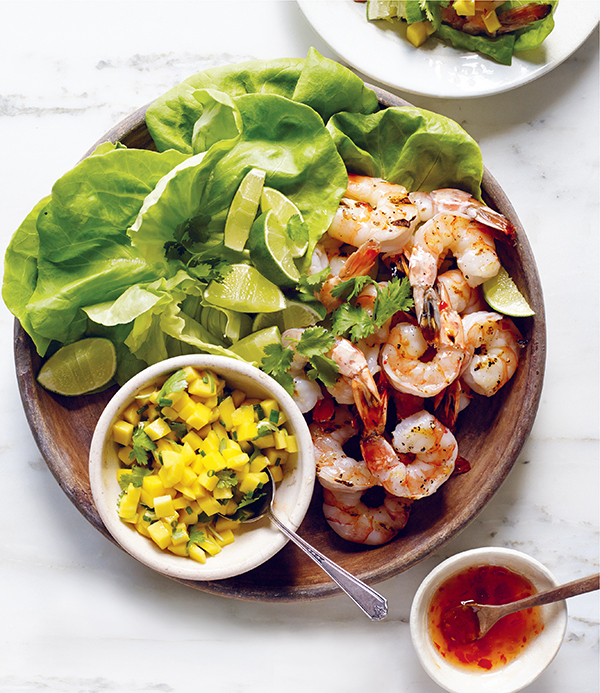
CHICKEN TIKKA MASALA WITH BROWN BASMATI RICE
If you like your tomato sauce even spicier, you can swap a pinch of the paprika for a pinch of cayenne pepper!
If there’s one dish guaranteed to show up at every Indian restaurant, this is it. Sometimes when I have it with naan bread, it’s kind of like having Indian pizza!
PREP TIME 30 MINUTES (PLUS 2 HRS FOR MARINATE) | COOK TIME 40 MINUTES | SERVES 6 | SMARTPOINTS 10 PER SERVING | CALORIES 425 PER SERVING
INGREDIENTS:
Chicken marinade
3 cloves garlic, minced
1-inch piece ginger, minced
¼ medium yellow onion, minced
Juice of 1 lime
1 teaspoon ground cumin
1 teaspoon ground coriander
¼ teaspoon ground cayenne
2 teaspoons paprika
3 tablespoons nonfat Greek yogurt
1 teaspoon kosher salt
2 pounds boneless, skinless chicken thighs, cut into 1½-inch cubes
Sauce
1 teaspoon ghee or canola oil
¼ medium red onion, sliced
½-inch piece ginger, minced
4 cloves garlic, minced
1 teaspoon ground coriander
1 teaspoon ground cumin
1 teaspoon crushed red pepper flakes
1 bay leaf
2 cups Pomi strained tomatoes
¼ cup heavy cream
Salt
2 teaspoons fresh lime juice, or to taste
Brown Basmati Rice
1 cup brown basmati rice
½ teaspoon ghee or canola oil
4 whole cloves
1 cup water or Great Chicken Stock (here)
½ teaspoon fine sea salt
DIRECTIONS:
To marinate the chicken: Combine all the marinade ingredients in a large bowl, add the chicken, and stir to fully coat. Place in the refrigerator and marinate for 2 hours, stirring a couple of times.
To roast the chicken: Preheat the broiler. Place the chicken on a roasting pan, removing most of the marinade, and broil until it starts to blacken in spots, about 10 minutes (it’s OK if the chicken is not cooked through; it will finish cooking in the sauce).
To make the sauce and finish the chicken: Heat the ghee in a large saucepan over medium-high heat. Add the onion and cook, stirring often, until well browned, about 5 minutes. Add the ginger, garlic, coriander, cumin, red pepper flakes, and bay leaf and cook, stirring, for about 1 minute, until aromatic, adding a tiny bit of water if the mixture starts to stick to the pan. Add the tomatoes, bring to a simmer, then reduce the heat and cook for 15 minutes. Add the chicken and cream, return to a simmer, and cook for 15 minutes. Remove the bay leaf, season with salt, stir in the lime juice, and serve over rice.
To make the rice: Preheat the oven to 350°F. Place the rice in a strainer and rinse it under cold running water. Shake to drain it well. Heat the ghee in a medium ovenproof saucepan over medium heat. Add the cloves and toast for about 1 minute, until aromatic. Add the rice and toast, stirring often, for 1 to 2 minutes, until lightly colored and aromatic. Add the water and salt and bring to a simmer. Cover, place in the oven, and cook for 40 minutes, or until all the water is absorbed. Remove the pan from the oven, let rest with the cover on for 10 minutes, then fluff the rice and serve.
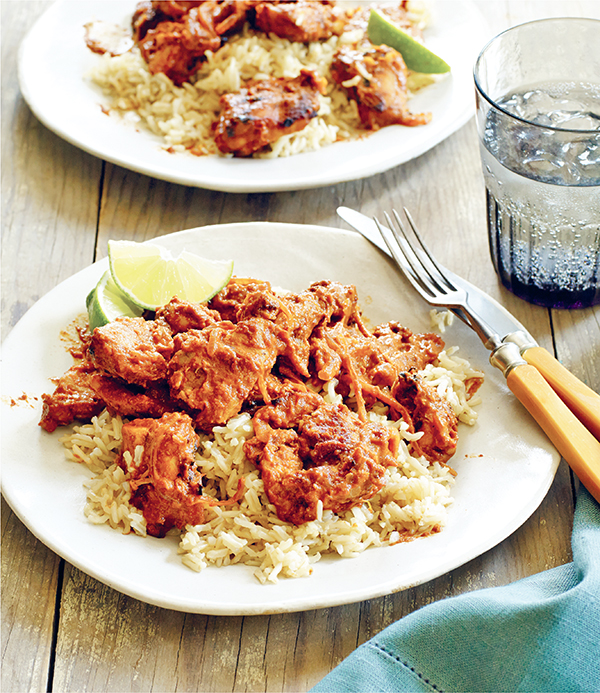
This is the perfect blend of color and texture, lightness and substance. And it’s really pretty on the plate, so if what they say about the first taste being with the eyes is true, you’re going to love this even before taking a bite.
PREP TIME 25 MINUTES | COOK TIME 15 MINUTES | SERVES 6 MAKES ABOUT 12 CUPS | SMARTPOINTS 6 PER SERVING | CALORIES 251 PER SERVING
INGREDIENTS:
Salad
4 boneless, skinless chicken breasts
1 teaspoon salt, or to taste
4 cups shredded Napa cabbage
4 scallions, thinly sliced diagonally
2 cups thinly sliced sugar snap peas
3 medium carrots, thinly sliced diagonally and cut into matchsticks
1 red bell pepper, cored, seeded, and thinly sliced
½ cup fresh mint leaves, torn into pieces
½ cup fresh cilantro leaves, torn into pieces
½ cup roasted cashews, roughly chopped
1 tablespoon black sesame seeds
Dressing
1⁄3 cup fresh lime juice, or to taste
1 serrano chile, seeded and minced
3 cloves garlic, grated on a Microplane
1-inch piece ginger, grated on a Microplane
1 tablespoon agave nectar
3 tablespoons fish sauce
1 tablespoon toasted sesame oil
DIRECTIONS:
To poach the chicken, place the breasts in a medium saucepan, add water to cover by 2 inches, then add ½ teaspoon salt. Place over medium-high heat and bring just to a simmer, then reduce the heat and cook at a very low simmer for about 15 minutes, until the breasts are cooked through and they reach a temperature of 160°F as measured on an instant-read thermometer. Remove the chicken from the poaching liquid to a cutting board, cool completely, then shred the chicken using your fingers or two forks.
To compose the salad, in a large salad bowl, toss the cabbage, scallions, sugar snap peas, carrots, and bell pepper with remaining salt. In a separate bowl, whisk together all the dressing ingredients, then toss well with the vegetables. Let sit for 10 minutes, then add the shredded chicken and toss to coat. Taste and add more salt or lime juice if needed. Mix in the mint and cilantro, top with the cashews and sesame seeds, and serve.
Fresh mint makes everything better!
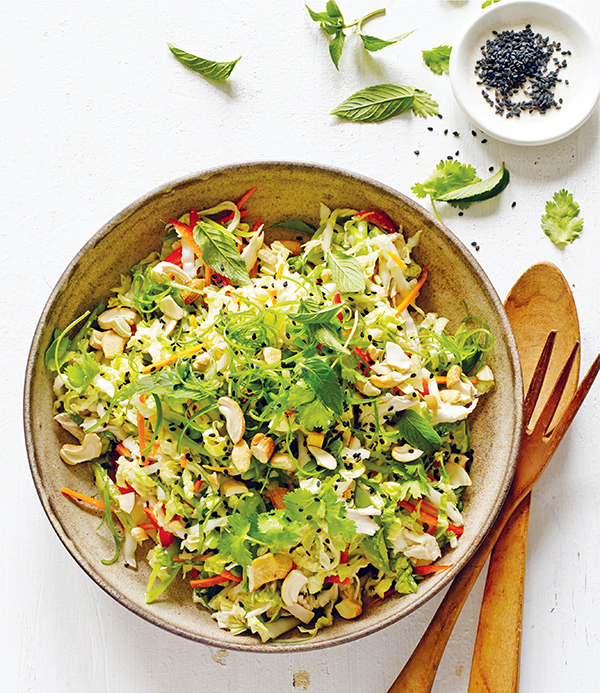
RECIPE INSPIRED BY RICK STEIN
There’s something very festive about this dish—it tastes like a holiday just waiting to be celebrated.
If you or your guests haven’t experienced much Indian food, this is a perfect introduction to the cuisine. People won’t necessarily be able to identify all the different spices—they’ll only know they want more than one helping!
PREP TIME 20 MINUTES | COOK TIME 30–40 MINUTES | SERVES 4 | SMARTPOINTS 9 PER SERVING | CALORIES 373 PER SERVING
INGREDIENTS:
1½ teaspoons ground Kashmiri chile
1 teaspoon ground cumin
1 teaspoon ground coriander
1 teaspoon garam masala
½ teaspoon ground turmeric
½ teaspoon ground cinnamon
½ teaspoon ground cayenne
¼ teaspoon ground cardamom
¼ teaspoon ground cloves
¼ teaspoon cracked black pepper
1 teaspoon salt, plus more if needed
1 (3½-pound) chicken, cut into 8 pieces, skin removed
2 tablespoons extra virgin olive oil
1 medium onion, finely chopped
1-inch piece ginger, peeled and grated
3 cloves garlic, peeled and chopped
4 medium plum tomatoes, seeds removed, finely chopped
2 tablespoons white wine vinegar
1 teaspoon brown sugar
¾ cup dried apricots, quartered
Leaves and tender stems of ½ bunch cilantro
DIRECTIONS:
Preheat the oven to 375°F. In a small bowl, combine the ground Kashmiri chile, cumin, coriander, garam masala, turmeric, cinnamon, cayenne, cardamom, cloves, and black pepper. Season the chicken all over with half of the spice mixture and ½ teaspoon of the salt.
In a large ovenproof sauté pan, heat the oil over medium-high heat. Add the onion and cook, stirring often, until lightly browned, about 5 minutes. Add the ginger and garlic and cook until fragrant, about 2 minutes. Add the chicken to the pan and cook for 3 to 4 minutes on each side, until lightly browned all over. Add the remaining half of the spice mixture, the tomatoes, vinegar, brown sugar, apricots, and the remaining ½ teaspoon salt. Add water to cover the chicken three-quarters of the way. Bring the mixture to a boil, cover, and turn off the heat. Place the pan in the oven and bake for 30 to 40 minutes, until an instant-read thermometer inserted into a breast reads 165°F.
Remove the pan from the oven. Using tongs, remove the chicken pieces from the pan to a serving bowl. Return the pan to the stovetop, place over high heat, and cook uncovered until the sauce is thickened, about 10 minutes. Stir in the cilantro and serve.

The low-fat salad dressing in this dish is so good drizzled over everything from noodles to chicken to green beans that I sometimes take it with me when I go out to eat. I also like keeping a supply in the fridge.
PREP TIME 20 MINUTES | COOK TIME 7 MINUTES | SERVES 4 | SMARTPOINTS 4 PER SERVING | CALORIES 186 PER SERVING
INGREDIENTS:
Spicy Sesame Ginger Dressing
1 tablespoon toasted sesame oil
3 tablespoons soy sauce or tamari
1½ tablespoons grated (on a Microplane) fresh ginger
3 tablespoons rice vinegar
1 tablespoon mirin
1 tablespoon chopped shallot
1 tablespoon chopped seeded jalapeño chile
1 tablespoon honey
Mirin is cooking wine; look for it in the Asian section of your supermarket.
Fish
12 ounces fresh, sashimi-grade albacore or ahi tuna (see Note), in a single rectangular piece
½ teaspoon salt
1 tablespoon coarsely ground black pepper
1½ tablespoons tan or black sesame seeds
1 tablespoon toasted sesame oil
3 small cucumbers, sliced
4 radishes, sliced
1 cup microgreens or sunflower sprouts
¼ cup chopped scallions
DIRECTIONS:
To make the dressing: Combine the toasted sesame oil, soy sauce or tamari, ginger, vinegar, mirin, shallot, jalapeño, and honey in a blender and blend until smooth.
To cook the fish: Sprinkle the tuna on both sides with the salt. On a large flat plate, combine the black pepper and sesame seeds and gently press the fish into the mixture.
Heat the toasted sesame oil in a large skillet over medium-high heat. Add the fish and sear both sides, about 1 minute per side for rare, or to desired doneness. Remove to a cutting board and thinly slice the fish against the grain.
Arrange the cucumber slices, radish slices, and microgreens on a serving plate to make a bed for the fish. Add the fish and garnish with the scallions. Drizzle ¼ cup of the dressing on top, reserving the rest for another recipe. Serve immediately.
Note: Drained canned albacore tuna packed in water can be used as a substitute for the fresh fish.
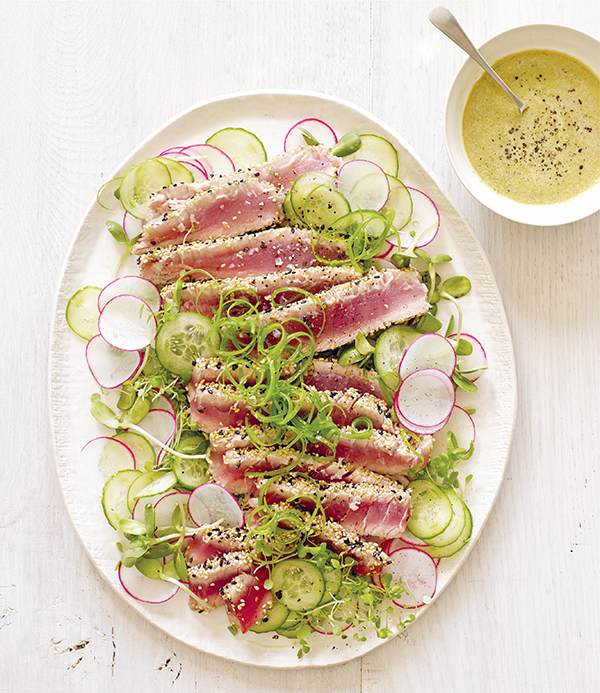
The dressing also tastes delicious over drained canned albacore tuna if fresh fish is unavailable.
THAI RED CURRY WITH SHRIMP AND PINEAPPLE
I love the incredible layers of flavor in this recipe. It’s bright, spicy, slightly sweet, and full of freshness.
PREP TIME 30 MINUTES | COOK TIME 30 MINUTES | SERVES 6 | SMARTPOINTS 6 PER SERVING | CALORIES 253 PER SERVING
INGREDIENTS:
1 tablespoon coconut oil
1-inch piece ginger, grated on a Microplane
2 shallots, minced
3 scallions, white parts only, chopped
2 cloves garlic, minced
1 serrano chile, seeds removed and thinly sliced
3 tablespoons prepared red curry paste, such as Thai Kitchen brand
1 (14-ounce) can unsweetened light coconut milk
2 teaspoons Thai fish sauce
2 teaspoons agave nectar
1½ pounds large shrimp, peeled and deveined
1 cup thinly sliced (on the diagonal) sugar snap peas
1 red bell pepper, cored, seeded, and julienned
1 yellow bell pepper, cored, seeded, and julienned
1 medium zucchini, cut into ¼-inch cubes
Up to ½ cup Vegetable Stock (here)
1 cup fresh or thawed frozen peas
1 cup cubed (½-inch cubes) fresh pineapple
Zest and juice of 1 lime, or to taste
Sea salt
Garnishes
Finely chopped fresh chives
Finely chopped fresh Thai basil
Whole fresh cilantro leaves
Steamed rice for serving (optional)
DIRECTIONS:
In a large sauté pan, heat the oil over medium heat. Add the ginger, shallots, scallions, garlic, and chile and cook for about 5 minutes, stirring often, until the shallots are softened. Add the red curry paste and cook, stirring often, for an additional 4 minutes, adding a tiny bit of water if the paste starts to stick to the bottom of the pan.
Pour in the coconut milk, fish sauce, and agave and bring to a simmer. Add the shrimp, sugar snap peas, bell pepper, and zucchini, and return to a simmer. Reduce the heat to medium-low and cook for 8 minutes, or until the shrimp is cooked through and the vegetables are crisp-tender, adding some vegetable stock if needed to keep all the ingredients moist. Add the peas, pineapple, and lime zest and juice and season with salt. Remove from heat and stir in the herb garnishes. Serve over rice if you like.
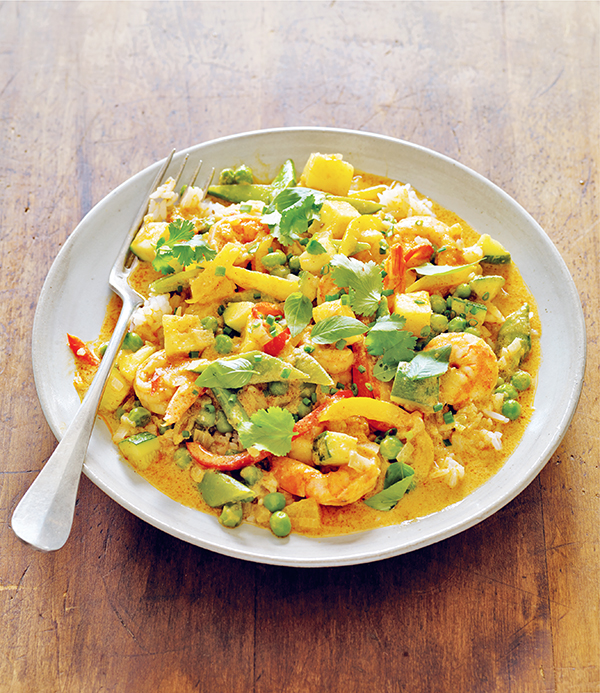
Colorful, tangy, and easy to throw together, this dish has a slightly tropical taste thanks to the pineapple, and that little hit of lime adds a nice bright flavor.
PREP TIME 20 MINUTES | COOK TIME 15 MINUTES | SERVES 6 | SMARTPOINTS 4 PER SERVING | CALORIES 163 PER SERVING
INGREDIENTS:
1 tablespoon toasted sesame oil
¼ cup chopped yellow onion
2 cloves garlic, minced
2 tablespoons diced carrot
½ cup diced fresh pineapple
3 cups cooked and cooled white rice (day-old is fine)
1½ tablespoons fish sauce
1½ tablespoons soy sauce
1 teaspoon freshly ground white pepper
2 large eggs, beaten
2 tablespoons fresh or thawed frozen peas Salt
2 tablespoons thinly sliced scallions
1 tablespoon chopped fresh cilantro
Juice of 1 lime
DIRECTIONS:
Heat the oil in a large nonstick skillet over medium heat. Add the onion and cook for about 5 minutes, until starting to soften, then add the garlic and cook for another minute, or until aromatic. Stir in the carrot and pineapple, then add the rice and stir well. Stir in the fish sauce, soy sauce, and white pepper, increase the heat to medium-high, and continue to cook, stirring, for 2 minutes.
Using a spatula, push the rice to the sides of the pan to make a large “well” in the middle of the fried rice. Pour the beaten eggs in the well, leave for about 30 seconds, then cover the eggs with the fried rice. Leave for 30 seconds to 1 minute, then continue to cook, stirring, until the egg is fully set and is incorporated into the fried rice, another minute or so. Add the peas, cook till warm throughout, season with salt if needed, then stir in the scallions, cilantro, and lime juice and serve.
Use the leftover pineapple to sweeten up plain yogurt.
JAPANESE BROWN RICE WITH KALE, AVOCADO, AND EDAMAME SALAD
RECIPE FROM PAULA NEL
I love this dish so much, I eat it as a complete meal.
I know this salad has more points than some of the others, but that’s a small price to pay for all the nutrients you’re getting. For example: One half cup of edamame (Japanese boiled or steamed soy beans) has 9 grams of protein and almost as much fiber as it does carbohydrates. It also contains around 10 percent of the daily value for vitamin A. And it’s high in iron to boot—it contains about as much as a 4-ounce roasted chicken breast.
PREP TIME 20 MINUTES | COOK TIME 10 MINUTES | SERVES 8 | SMARTPOINTS 9 PER SERVING | CALORIES 332 PER SERVING
INGREDIENTS:
Dashi Stock
4 cups water
1 (4-inch) piece kombu seaweed
1 cup bonito flakes
Rice Salad
2 cups short-grain Japanese brown rice
Salt
3 cloves garlic, thinly sliced
3 tablespoons extra virgin olive oil
2 cups roughly chopped kale leaves
1 cup cooked edamame
¼ cup toasted pumpkin seeds
¼ cup toasted sunflower seeds
¼ cup toasted sesame seeds
2 tablespoons light soy sauce, or to taste
1 tablespoon yuzu juice or lemon juice, or to taste
2 scallions, white and light green parts, sliced
1 ripe avocado, cut in half, pit removed, and flesh sliced from the skin
DIRECTIONS:
To make the dashi stock: In a large saucepan, combine the water and kombu over medium-high heat and bring to a low simmer. Immediately reduce the heat to low and simmer for 10 minutes. Remove the pot from the heat and add the bonito flakes. Cover and set aside for 15 minutes to steep the bonito flakes. Strain the dashi through a fine-mesh strainer into a bowl and discard the kombu and bonito flakes.
To make the rice: Rinse out the pan you cooked the dashi stock in, return the stock to the pan, and bring to a boil over medium-high heat. Add the rice and 1 teaspoon salt, return to a simmer, then reduce the heat to low, cover, and cook until the water is absorbed and the rice is cooked through, about 45 minutes. Remove from the heat and leave the lid on for 10 minutes, then fluff with a fork, transfer to a serving bowl, and cool to room temperature.
While the rice is cooking, make the garlic oil: In a very small pot (a sturdy stainless steel measuring cup works well) or skillet, combine the garlic and oil. Place over low heat, bring to a low simmer, and cook for about 5 minutes, until it is lightly browned and fragrant.
To assemble the salad: Place the kale in a medium bowl, add a pinch of salt, and rub the kale between your fingers for a minute or two, until slightly wilted. Add the kale to the rice, then stir in the garlic and its oil, the edamame, most of the pumpkin seeds, sunflower seeds, and sesame seeds (reserving a little for garnish), the soy sauce, yuzu or lemon juice, and scallions. Season with salt and pepper and fold in the avocado just before serving. Spoon into bowls and serve with the reserved seeds sprinkled on top.
VELVET SHRIMP WITH CARROT GINGER PUREE AND TAMARIND ONION CARAMEL
What do Chinese restaurants know that a lot of home cooks do not? It’s called velveting! This is a technique unique to Chinese cuisine that gives meat and seafood a juicy, delectable consistency.
PREP TIME 30 MINUTES | COOK TIME 1 HOUR | SERVES 6 | SMARTPOINTS 10 PER SERVING | CALORIES 324 PER SERVING
INGREDIENTS:
Carrot Ginger Puree
1 pound carrots, thinly sliced
1½ cups carrot juice
1 tablespoon grated (on a Microplane) ginger
½ teaspoon salt
Shrimp and marinade
1 pound medium shrimp, peeled and deveined
2 tablespoons cornstarch
1 teaspoon ground white pepper
1 teaspoon onion powder
½ teaspoon salt
¼ cup Shaoxing wine or dry sherry
2 teaspoons grated (on a Microplane) ginger
2 teaspoons grated (on a Microplane) garlic
Tamarind Onion Caramel
1 tablespoon tamarind concentrate
½ medium yellow onion, chopped
¼ cup fish sauce
¼ cup carrot juice
2 cloves garlic, grated on a Microplane
1½ cups sugar
Coating and frying the shrimp
2 large egg whites
½ teaspoon salt
2 tablespoons cornstarch
½ cup canola oil
Garnishes
Julienne slices of multicolored carrots
Thinly sliced scallion greens
Fresh cilantro leaves
DIRECTIONS:
To make the carrot ginger puree: Combine the carrots, carrot juice, ginger, and salt in a medium saucepan. Place over medium-high heat and bring to a boil. Reduce the heat to medium-low and simmer, stirring often, for 25 minutes, or until the carrots are very tender.
Strain the carrots and reserve the cooking liquid. Transfer the carrots to a blender and blend until smooth, stopping to scrape down the sides of the machine as needed and adding some of the reserved cooking liquid, 1 tablespoon at a time, to achieve a puree consistency.
While the carrots are cooking, marinate the shrimp: Rinse the shrimp under cold running water, drain, and blot dry with paper towels. In a medium bowl, whisk together the cornstarch, white pepper, onion powder, and salt. Whisk in the wine, then add the ginger and garlic. Add the shrimp and toss to coat in the marinade. Place in the refrigerator to marinate for up to 30 minutes.
While the shrimp is marinating, make the tamarind onion caramel: In a blender, combine the tamarind concentrate, onion, ¼ cup water, the fish sauce, and carrot juice and blend until smooth. Add the garlic.
Combine the sugar with ¼ cup water in a small, heavy saucepan such as an enameled cast-iron pan. Place over medium-low heat and leave undisturbed for about 3 minutes, until the sugar has dissolved, brushing off any sugar crystals that form on the sides with a wet pastry brush.
Continue to cook, occasionally swirling, not stirring, the pot to keep the mixture moving. The mixture will start to bubble and deepen in color. Once the caramel is a medium-dark amber color, 5 to 7 minutes, add the tamarind mixture and remove from the heat. It will bubble furiously. After the bubbling subsides, return the pan to medium-low heat and cook for 10 minutes, or until the caramel is the consistency of runny honey. If the caramel threatens to boil over, remove it from the heat for a few seconds until it goes back down. Note that the caramel will continue to thicken as it cools. Leftover caramel can be stored in the refrigerator, reheated to thin it, and used as a marinade for chicken or seafood.
To coat and fry the shrimp: Place the egg whites and salt in an electric mixer and mix on low speed until frothy. Add the cornstarch and continue to mix, slowly increasing the speed to medium, until the whites form soft to medium peaks. Drain the shrimp from the marinade, add the shrimp to the whites, and fold lightly to coat.
Set a wire rack atop a baking sheet. Heat the oil in a wok or large skillet over medium heat. Using tongs, add the shrimp, one at a time, being careful of spattering oil. Cook on each side for about 2 minutes, until browned and cooked through. As the shrimp are done, use tongs to place them on the wire rack. If the shrimp are finished before the other components are, keep them warm in a 200°F oven.
To serve: Arrange the shrimp on plates, add a scoop of the carrot ginger puree, drizzle with 1 to 1½ tablespoons caramel, and serve topped with the garnishes.
The caramel is spicy, savory, rich, and sweet. Feel free to make a batch to drizzle over chicken too!
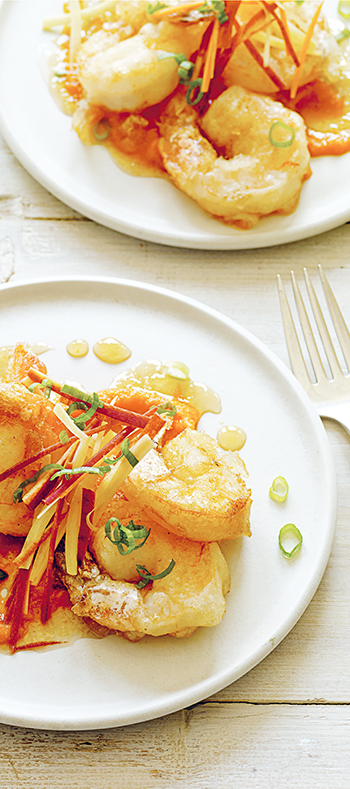
Toasting your spices to make the curry sauce may be an extra step, but it’s a step well worth taking. It not only scents your kitchen, it really revs up all of the flavors.
PREP TIME 20 MINUTES | COOK TIME 25 MINUTES | SERVES 6 | SMARTPOINTS 6 PER SERVING | CALORIES 217 PER SERVING
INGREDIENTS:
Curry paste
MAKES ABOUT 1 CUP
1 tablespoon coriander seeds
1½ teaspoons cumin seeds
½ teaspoon white peppercorns
2 tablespoons thinly sliced fresh cilantro stems
1½ tablespoons chopped fresh galangal
1½ tablespoons chopped fresh ginger
¼ cup chopped garlic
1 kaffir lime leaf, torn into pieces
¼ cup sliced fresh lemongrass
1 tablespoon kosher salt
½ cup sliced shallots
1 teaspoon shrimp paste
4 green Thai bird chiles, stemmed and chopped
4 jalapeño chiles, stemmed and chopped
2 serrano chiles, stemmed and chopped
Curry
1 tablespoon coconut oil
1 red onion, chopped
2 tablespoons minced garlic
2 kaffir lime leaves
¼ cup green curry paste (see above)
1 pound boneless, skinless chicken breasts or thighs, cut into bite-size pieces
1 (14.5-ounce) can light coconut milk
1 red bell pepper, cored, seeded, and chopped
1 yellow bell pepper, cored, seeded, and chopped
½ cup chopped (1-inch pieces) asparagus
½ cup chopped (1-inch pieces) green beans
1 cup chopped bok choy
4 cups fresh spinach leaves
1½ tablespoons fish sauce, or to taste
1 tablespoon coconut sugar (optional)
Do a sweep of your cupboards from time to time. Old Spice only works as an aftershave!
DIRECTIONS:
To make the curry paste: Heat a small skillet over medium heat. Add the coriander seeds, cumin seeds, and peppercorns and toast, stirring often, until aromatic and the seeds turn a couple of shades darker. Remove from the skillet to a plate to cool briefly.
Combine all of the ingredients in a mini food processor and blitz to a paste. The paste will keep in a lidded container in the refrigerator for up to 3 weeks or in the freezer for up to 2 months.
To make the curry: Heat the oil in a large saucepan over medium heat. Add the onion and cook for about 5 minutes, until starting to soften. Add the garlic and lime leaves and cook for about 2 minutes more, until aromatic. Add the green curry paste and cook for about 3 minutes, stirring often, until lightly colored and aromatic. Stir in the chicken to coat it in the curry paste; cook, stirring, for 5 minutes. Add the coconut milk and bring to a simmer.
Add the bell peppers, asparagus, and green beans, return to a simmer, then reduce the heat and simmer for about 5 minutes, until the vegetables start to soften. Add the bok choy and cook for another 3 minutes, or until all the vegetables are softened and the chicken is cooked through. Set a strainer atop a blender and strain the curry sauce from the pan into the blender, returning the vegetables to the pan. Add the spinach to the blender and blend until smooth and bright green in color. Pour the blended spinach into the pan and add the fish sauce and coconut sugar, if using. Taste and add more fish sauce if needed. Serve immediately, over steamed brown rice if you like.
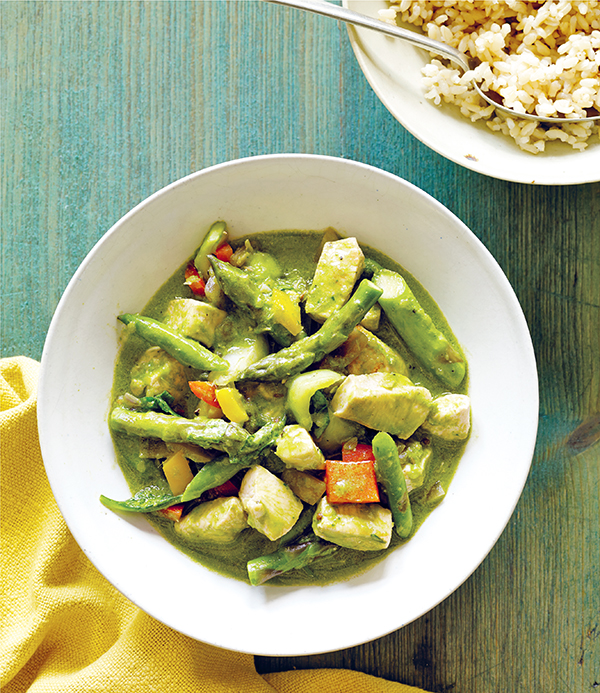
People take black pepper for granted. But in my kitchen it’s an MVP! I grind it over everything from scrambled eggs to cauliflower mashed potatoes. Warning: That pre-ground powdery stuff is like adding a dusting of dust.
Whether it’s powdered, granulated, raw, blanched, roasted, dehydrated, sautéed, or mashed with salt and made into a paste, garlic is a must. The only thing I don’t put it in is dessert.
With both smoky and spicy notes, these peppers bring a wallop of flavor to marinades, sauces, and stews.
Truffles are the ultimate posh spice. But Truffle Zest only tastes expensive. I’ve been known to keep it in my bag when I go out to eat.
I don’t know why celery seeds don’t get more play. They add a nice twist to all kinds of salads, smothered chicken, even a Bloody Mary.
Almost anything that’s delicious without a touch of lemon (salad dressing, popcorn, veggies, fish) will be even more delicious with a touch of lemon!
To smell vanilla fresh from the pod is to never want to exhale—it’s a fragrant spice with a rich finish. I like adding it to water with ginger and mint for a no-calorie cocktail.
Where to begin? First of all, basil is a tomato’s best friend! I keep a basil plant in the kitchen and sometimes I just like to cup it in my hands and breathe in the scent of summer.
I’ve never met a chile I didn’t like! And here’s a bonus: Red chile flakes keep me from adding extra salt. Just don’t rub your eyes with fingers that have recently added a pinch of it to something.
Ginger is pure personality. It’s soulful, healing, exotic, and spicy. I use it to flavor water, tea, and almost all of my Asian and Indian dishes.
